The Role of Environmental Conditions on Marathon Running Performance in Men Competing in Boston Marathon from 1897 to 2018
Abstract
1. Introduction
2. Materials and Methods
2.1. Ethical Approval
2.2. Data Sampling and Data Analysis
2.3. Statistical Analysis
where S(YEAR, k) denoted a spline, changing with calendar year and with k basis dimension. K was set equal to nine. Observations before 1944 were discarded because of incomplete information about weather conditions. As a first analysis, all weather variables: temperature, WBGT, precipitations, wind direction, wind speed, and pressure were included into the multi-variable model. Subsequently, WBGT and pressure were discarded, in all groups of finishers, due to multi-collinearity, assessed by computing the variance inflation factor (or VIF) score. All predictors with VIF not greater than 10 were retained in the model. According to this criterion, in all finishers group, precipitations variable was also dropped. Instead, in top ten finishers the wind speed variable was discarded. Partial effects, which are the isolated effects of one particular predictor or interaction, were shown graphically. Moreover, the effects of pressure and WBGT on performance, discarded in the multi-variable model, where also assessed, more rigorously, through uni-variable linear mixed models, which corrected for repeated measurements.Race Time (Y) ~ [Fixed effects (X) = Weather Conditions + S(YEAR, k)+ [Random effects of intercept = Runners]
3. Results
3.1. Summary Statistics
3.2. Statistical Models
3.2.1. Weather Conditions
3.2.2. Calendar Year Effect and Weather Conditions
4. Discussion
5. Conclusions
Author Contributions
Funding
Conflicts of Interest
Appendix A
| (02:00, 02:30] | (02:30, 03:00] | (03:00, 03:30] | (03:30, 04:00] | (04:00, 04:30] | (04:30, 05:00] | (05:00, 05:30] | (05:30, 06:00] | >06:00 | |
|---|---|---|---|---|---|---|---|---|---|
| N | 3966 | 55,423 | 127,016 | 98,763 | 47,915 | 27,513 | 13,489 | 7017 | 2879 |
| Temperature (°C) | N (%) | ||||||||
| 0–7 | 1134 (28.6) | 15,941 (28.8) | 38,080 (30.0) | 30,289 (30.7) | 14,577 (30.4) | 8513 (30.9) | 4287 (31.8) | 2193 (31.3) | 1166 (40.5) |
| 8–15 | 2663 (67.1) | 36,372 (65.6) | 78,335 (61.7) | 54,992 (55.7) | 23,696 (49.5) | 12,580 (45.7) | 5497 (40.8) | 2648 (37.7) | 866 (30.1) |
| 16–23 | 169 (4.3) | 3106 (5.6) | 10,585 (8.3) | 13,482 (13.7) | 9642 (20.1) | 6420 (23.3) | 3705 (27.5) | 2176 (31.0) | 847 (29.4) |
| 24–30 | 0 (0.0) | 4 (0.0) | 16 (0.0) | 0 (0.0) | 0 (0.0) | 0 (0.0) | 0 (0.0) | 0 (0.0) | 0 (0.0) |
| Wind direction | N (%) | ||||||||
| West | 607 (15.6) | 8299 (15.2) | 20,746 (16.4) | 15,516 (15.7) | 7133 (14.9) | 3454 (12.6) | 1421 (10.5) | 672 (9.6) | 118 (4.1) |
| East | 1003 (25.8) | 18,574 (34.0) | 54,990 (43.5) | 47,608 (48.3) | 23,833 (49.7) | 13,847 (50.3) | 6904 (51.2) | 3414 (48.7) | 1418 (49.3) |
| North | 1067 (27.4) | 12,476 (22.8) | 22,573 (17.8) | 14,466 (14.7) | 6567 (13.7) | 3627 (13.2) | 1753 (13.0) | 830 (11.8) | 49 (1.7) |
| South | 1216 (31.2) Missing = 73 | 15,343 (28.1) Missing = 731 | 28,162 (22.3) Missing = 545 | 21,075 (21.4) Missing = 98 | 10,379 (21.7) Missing = 3 | 6585 (23.9) | 3411 (25.3) | 2101 (29.9) | 1294 (44.9) |
| Precipitation (mm) | N (%) | ||||||||
| 0 | 1869 (47.1) | 27,591 (49.8) | 70,690 (55.7) | 57,256 (58.0) | 28,242 (58.9) | 15,986 (58.1) | 7927 (58.8) | 4233 (60.3) | 1555 (54.0) |
| >0 | 2097 (52.9) | 27,831 (50.2) Missing = 1 | 56,322 (44.3) Missing = 4 | 41,505 (42.0) Missing = 2 | 19,670 (41.1) Missing = 3 | 11,527 (41.9) | 5562 (41.2) | 2784 (39.7) | 1324 (46.0) |
| WBGT (°C) | N (%) | ||||||||
| 0–6 | 2260 (58.1) | 29,132 (53.3) | 61,972 (49.0) | 45,244 (45.9) | 21,621 (45.1) | 12,829 (46.6) | 6551 (48.6) | 3418 (48.7) | 1745 (60.6) |
| 7–10 | 1362 (35.0) | 21,183 (38.7) | 53,463 (42.3) | 41,553 (42.1) | 18,686 (39.0) | 9621 (35.0) | 4061 (30.1) | 1893 (27.0) | 292 (10.1) |
| 11–15 | 250 (6.4) | 3933 (7.2) | 9190 (7.3) | 8481 (8.6) | 4783 (10.0) | 3204 (11.6) | 1808 (13.4) | 1098 (15.6) | 278 (9.7) |
| 16–20 | 21 (0.5) Missing = 73 | 444 (0.8) Missing = 731 | 1846 (1.5) Missing = 545 | 3387 (3.4) Missing = 98 | 2822 (5.9) Missing = 3 | 1859 (6.8) | 1069 (7.9) | 608 (8.7) | 564 (19.6) |
| Wind speed (km/h) | N (%) | ||||||||
| 0–15 | 893 (23.1) | 12,849 (23.5) | 29,722 (23.5) | 23,428 (23.7) | 11,322 (23.6) | 6835 (24.8) | 3403 (25.2) | 1775 (25.3) | 711 (24.7) |
| 16–17 | 1068 (27.6) | 15,776 (28.9) | 35,736 (28.3) | 26,589 (26.9) | 12,877 (26.9) | 6937 (25.2) | 3319 (24.6) | 1618 (23.1) | 590 (20.5) |
| 18–38 | 1911 (49.4) Missing = 94 | 26,049 (47.6) Missing = 749 | 61,029 (48.2) Missing = 529 | 48,654 (49.3) Missing = 92 | 23,713 (49.5) Missing = 3 | 13,741 (49.9) | 6767 (50.2) | 3624 (51.6) | 1578 (54.8) |
| Pressure (hPa) | N (%) | ||||||||
| <1015 | 2172 (54.8) | 26,280 (47.4) | 56,049 (44.1) | 42,403 (42.9) | 19,951(41.6) | 11,263 (40.9) | 5200 (38.5) | 2611 (37.2) | 1313 (45.6) |
| ≥1015 | 1721 (43.4) Missing = 73 | 28,412 (51.3) Missing = 731 | 70,422 (55.4) Missing = 545 | 56,262 (57.0) Missing = 98 | 27,961 (58.4) Missing = 3 | 16,250 (59.1) | 8289 (61.5) | 4406 (62.8) | 1566 (54.4) |
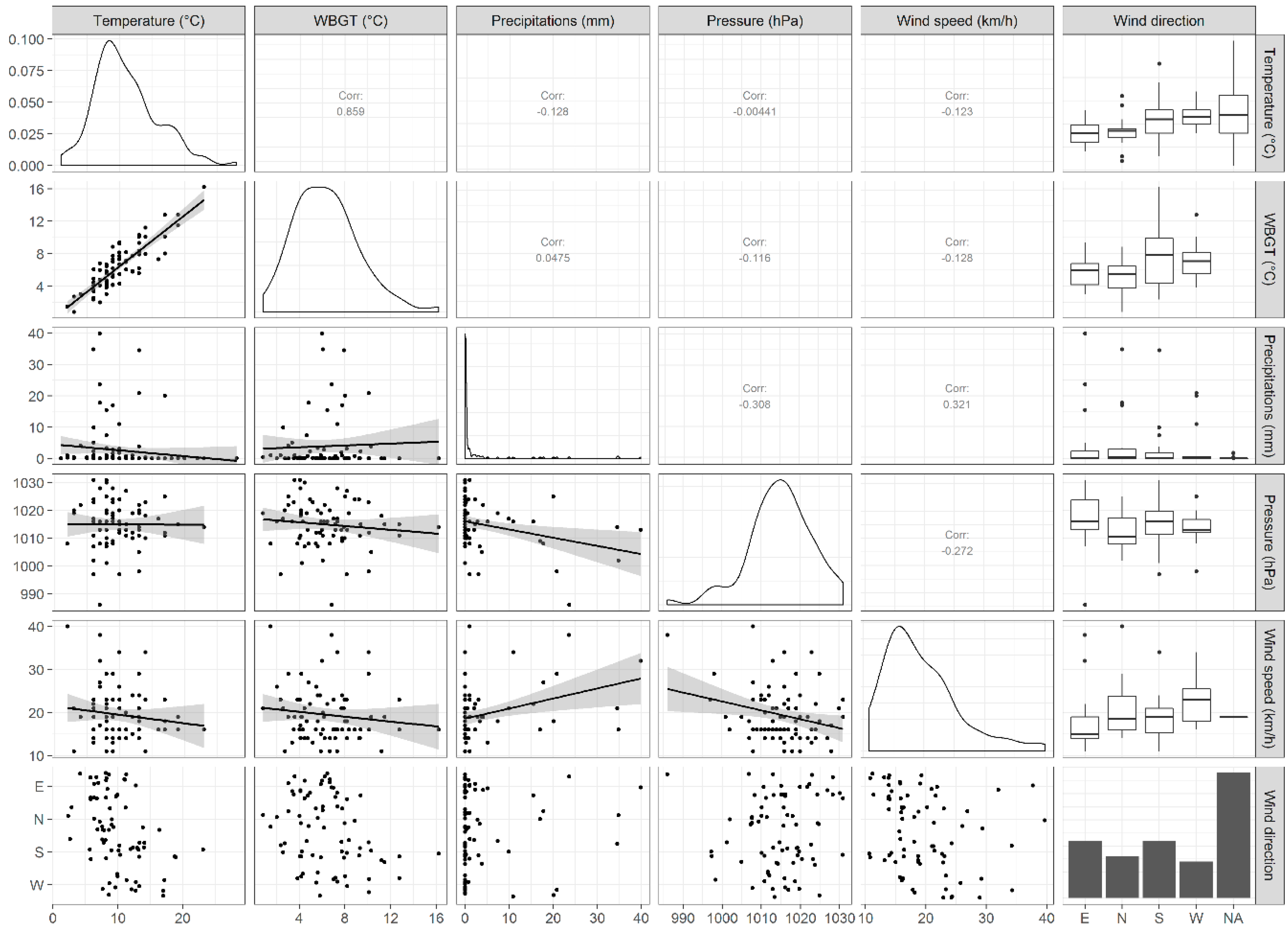
References
- Arcelli, E.; Molteni, G. Heat balance in marathon running. Med. Lav. 1976, 67, 183–195. [Google Scholar]
- Nielsen, B. Olympics in Atlanta: a fight against physics. Med. Sci. Sports Exerc. 1996, 28, 665–668. [Google Scholar] [CrossRef]
- Meinders, A.J.; Meinders, A.E. Hyponatraemia during a long-distance run: Due to excessive fluid intake. Ned. Tijdschr. Geneeskd. 2007, 151, 581–587. [Google Scholar]
- Furman, J.A.; Assell, C. Teaching Case: Acute, Exercise-Induced Compartment Syndrome, Rhabdomyolysis, and Renal Failure—A Case Report. Nutr. Clin. Pr. 1999, 14, 296–298. [Google Scholar] [CrossRef]
- Vihma, T. Effects of weather on the performance of marathon runners. Int. J. Biometeorol. 2009, 54, 297–306. [Google Scholar] [CrossRef]
- Ogueta-Alday, A.; García-López, J. Factores que afectan al rendimiento en carreras de fondo. [Factors affecting long-distance running performance]. Rev. Int. Cienc. Deporte. 2016, 12, 278–308. [Google Scholar] [CrossRef]
- Roberts, W.O. Heat and cold: what does the environment do to marathon injury? Sports Med. 2007, 37, 400–403. [Google Scholar] [CrossRef]
- Maughan, R.J. Distance running in hot environments: a thermal challenge to the elite runner. Scand. J. Med. Sci. Sports 2010, 20, 95–102. [Google Scholar] [CrossRef]
- Trapasso, L.M.; Cooper, J.D. Record performances at the Boston Marathon: Biometeorological factors. Int. J. Biometeorol. 1989, 33, 233–237. [Google Scholar] [CrossRef]
- Suping, Z.; Guanglin, M.; Yanwen, W.; Ji, L. Study of the relationships between weather conditions and the marathon race, and of meteorotropic effects on distance runners. Int. J. Biometeorol. 1992, 36, 63–68. [Google Scholar] [CrossRef]
- Dennis, S.C.; Noakes, T.D. Advantages of a smaller bodymass in humans when distance-running in warm, humid conditions. Graefes. Arch. Clin. Exp. Ophthalmol. 1999, 79, 280–284. [Google Scholar] [CrossRef]
- El Helou, N.; Tafflet, M.; Berthelot, G.; Tolaini, J.; Marc, A.; Guillaume, M.; Hausswirth, C.; Toussaint, J.-F. Impact of Environmental Parameters on Marathon Running Performance. PLoS ONE 2012, 7, e37407. [Google Scholar] [CrossRef]
- Ely, M.R.; Cheuvront, S.N.; Roberts, W.O.; Montain, S.J. Impact of Weather on Marathon-Running Performance. Med. Sci. Sports Exerc. 2007, 39, 487–493. [Google Scholar] [CrossRef]
- Maffetone, P.B.; Malcata, R.; Rivera, I.; Laursen, P.B. The Boston Marathon versus the World Marathon Majors. PLoS ONE 2017, 12, e0184024. [Google Scholar] [CrossRef]
- Knechtle, B.; Di Gangi, S.; Rüst, C.A.; Rosemann, T.; Nikolaidis, P.T. Men’s Participation and Performance in the Boston Marathon from 1897 to 2017. Int. J. Sports Med. 2018, 39, 1018–1027. [Google Scholar] [CrossRef]
- Lepers, R.; Cattagni, T. Do older athletes reach limits in their performance during marathon running? AGE 2012, 34, 773–781. [Google Scholar] [CrossRef]
- Jokl, P.; Sethi, P.M.; Cooper, A.J. Master’s performance in the New York City Marathon 1983–1999. Br. J. Sports Med. 2004, 38, 408–412. [Google Scholar] [CrossRef]
- Cheuvront, S.N.; Caruso, E.M.; Heavens, K.R.; Karis, A.J.; Santee, W.R.; Troyanos, C.; D’Hemecourt, P. Effect of WBGT index measurement location on heat stress category classification. Med. Sci. Sports Exerc. 2015, 47, 1958–1964. [Google Scholar] [CrossRef]
- Bergeron, M.F. Heat stress and thermal strain challenges in running. J. Orthop. Sports Phys. 2014, 44, 831–838. [Google Scholar] [CrossRef]
- Falk, B.; Nini, A.; Zigel, L.; Yahav, Y.; Aviram, M.; Rivlin, J.; Bentur, L.; Avital, A.; Dotan, R.; Blau, H. Effect of low altitude at the Dead Sea on exercise capacity and cardiopulmonary response to exercise in cystic fibrosis patients with moderate to severe lung disease. Pediatr. Pulmonol. 2006, 41, 234–241. [Google Scholar] [CrossRef]
- McAlindon, T.; Formica, M.; Schmid, C.H.; Fletcher, J. Changes in barometric pressure and ambient temperature influence osteoarthritis pain. Am. J. Med. 2007, 120, 429–434. [Google Scholar] [CrossRef]
- Miller-Rushing, A.J.; Primack, R.B.; Phillips, N.; Kaufmann, R.K. Effects of warming temperatures on winning times in the Boston Marathon. PLoS ONE 2012, 7, e43579. [Google Scholar] [CrossRef]
- Knechtle, B.; Di Gangi, S.; Rüst, C.A.; Nikolaidis, P.T. Performance differences between the sexes in the Boston Marathon from 1972 to 2017. J. Strength Cond. Res. 2019. [Google Scholar] [CrossRef]
- Cheuvront, S.N.; Haymes, E.M. Thermoregulation and marathon running: biological and environmental influences. Sports Med. 2001, 31, 743–762. [Google Scholar] [CrossRef]
- Fink, W.J.; Costill, D.L.; Van Handel, P.J.; Handel, P.J. Leg muscle metabolism during exercise in the heat and cold. Graefes. Arch. Clin. Exp. Ophthalmol. 1975, 34, 183–190. [Google Scholar] [CrossRef]
- Buresh, R.; Berg, K.; Noble, J. Heat production and storage are positively correlated with measures of body size/composition and heart rate drift during vigorous running. Res. Q. Exerc. Sport 2005, 76, 267–274. [Google Scholar] [CrossRef]
- Gordon, D.; Wightman, S.; Basevitch, I.; Johnstone, J.; Espejo-Sanchez, C.; Beckford, C.; Boal, M.; Scruton, A.; Ferrandino, M.; Merzbach, V.; et al. Physiological and training characteristics of recreational marathon runners. OAJSM 2017, 8, 231–241. [Google Scholar] [CrossRef]
- Pugh, L.G.C.E. Oxygen intake in track and treadmill running with observations on the effect of air resistance. J. Physiol. 1970, 207, 823–835. [Google Scholar] [CrossRef]
- Lloyd, A.; Havenith, G. Interactions in human performance: an individual and combined stressors approach. Temperature 2016, 3, 514–517. [Google Scholar] [CrossRef]
- Haugen, T.A.; Solberg, P.A.; Foster, C.; Morán-Navarro, R.; Breitschädel, F.; Hopkins, W.G. Peak age and performance progression in world-class track-and-field athletes. Int. J. Sports Physiol. Perform. 2018, 13, 1122–1129. [Google Scholar] [CrossRef]
- Marc, A.; Sedeaud, A.; Schipman, J.; Antero, J.J.; Saulière, G.; O Kryger, K.; Toussaint, J.F. Geographic enrollment of the top 100 in athletics running events from 1996 to 2012. J. Sports Med. Phys. Fitness 2015, 57, 418–425. [Google Scholar]
- Knechtle, B.; Nikolaidis, P.T.; Onywera, V.O.; Zingg, M.A.; Rosemann, T.; Rüst, C.A. Male and female Ethiopian and Kenyan runners are the fastest and the youngest in both half and full marathon. SpringerPlus 2016, 5, 223. [Google Scholar] [CrossRef]
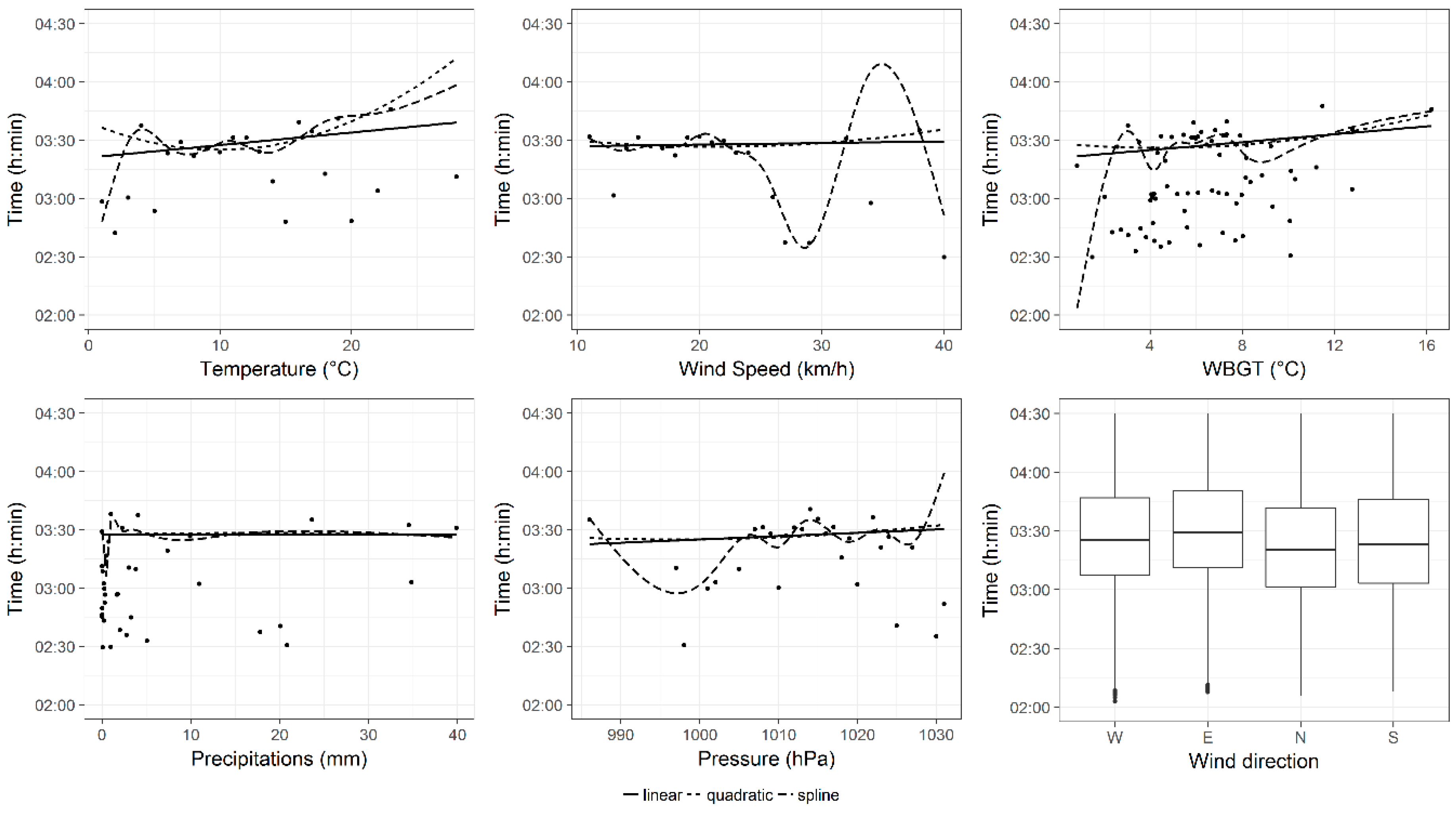
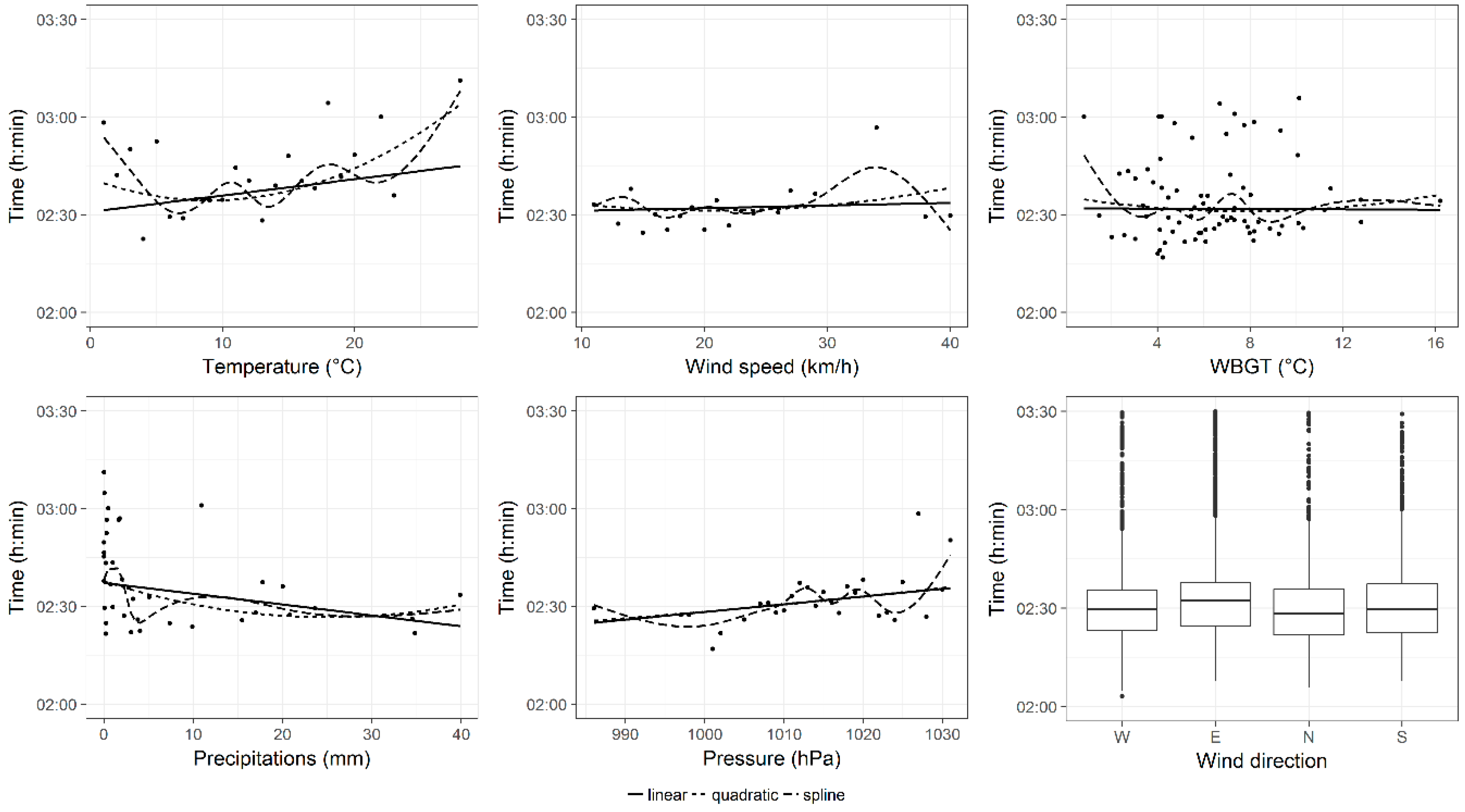
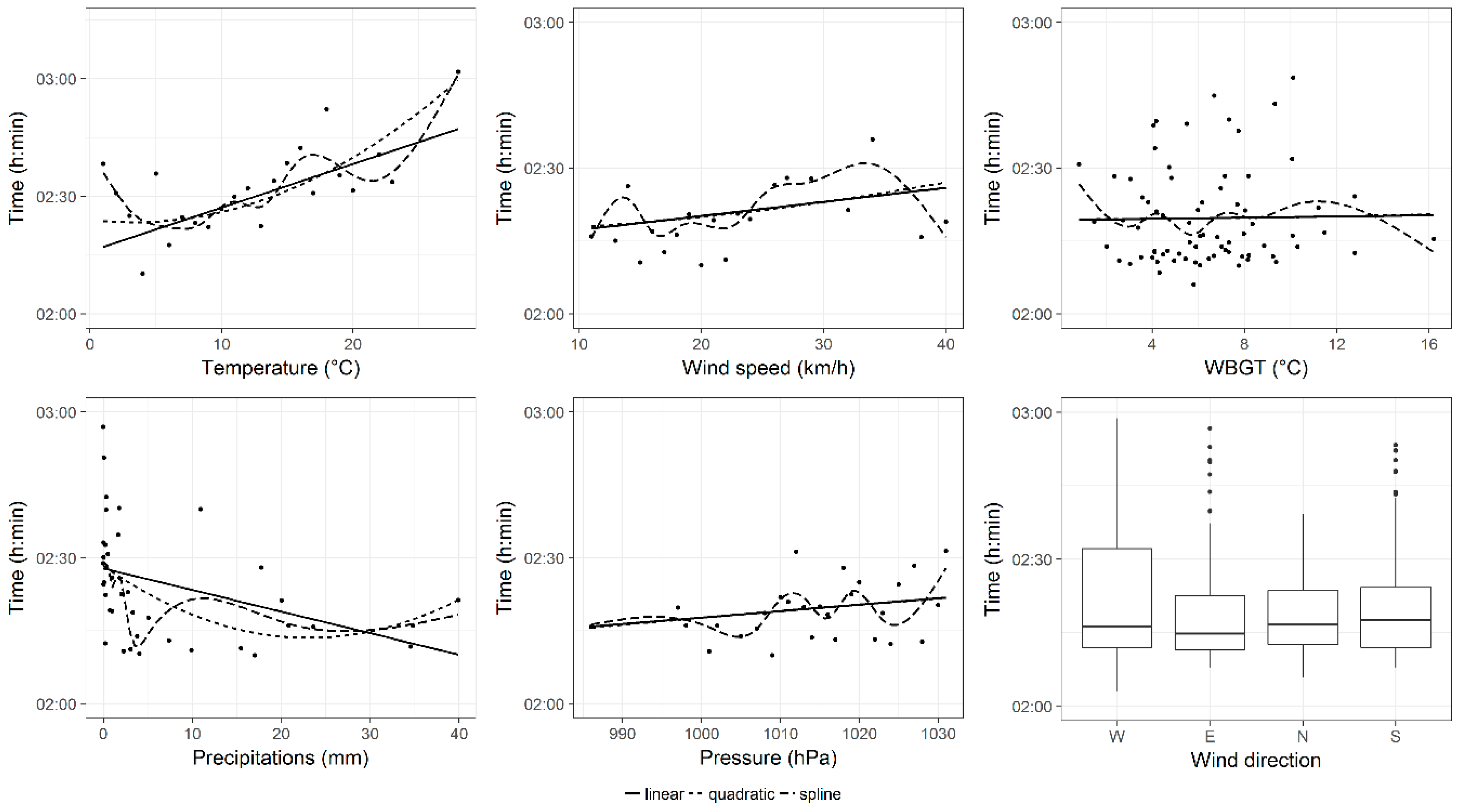
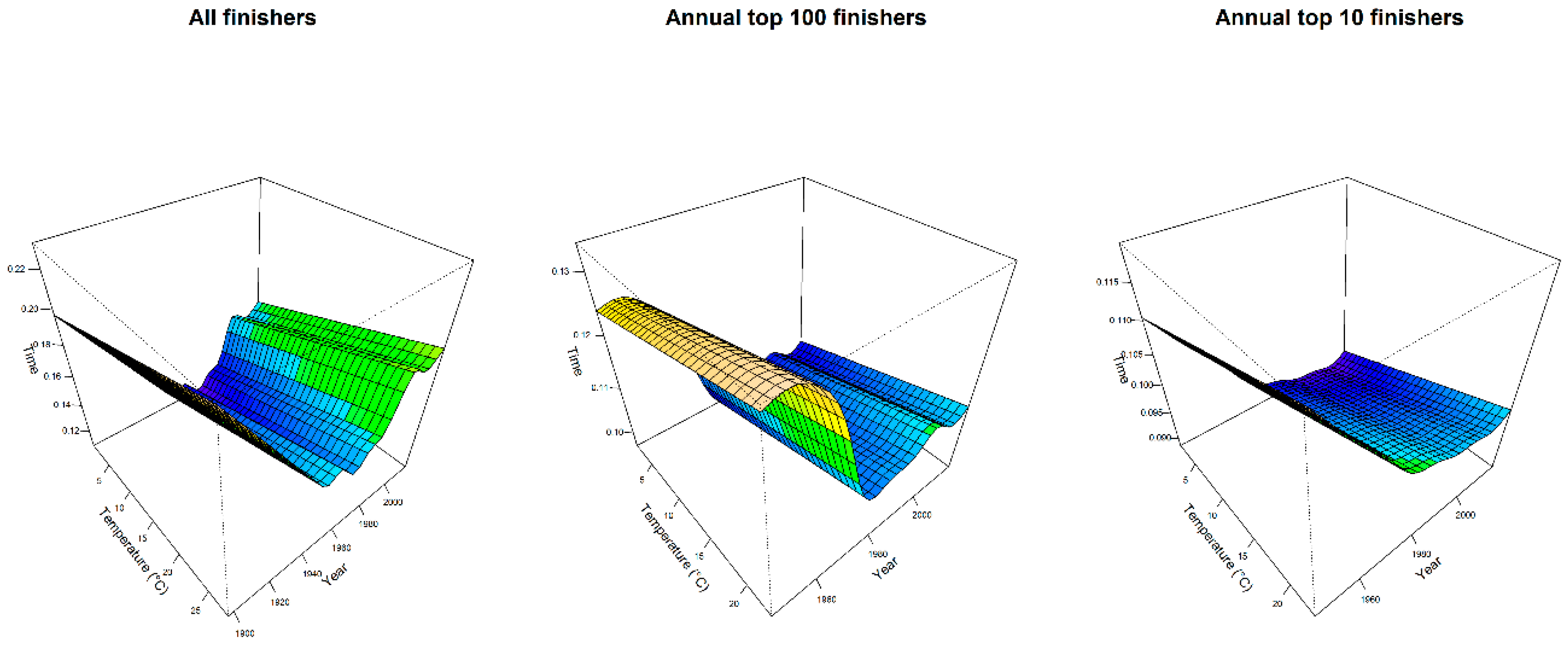

| All Finishers (N = 383,982) | Top 100 (N = 7713) | Top 10 (N = 1215) | |||||||
|---|---|---|---|---|---|---|---|---|---|
| Temperature (°C) | N | Mean | SD | N | Mean | SD | N | Mean | SD |
| 0–7 | 116,180 | 03:41:51 | 00:44:41 | 1817 | 02:34:57 | 00:18:16 | 259 | 02:23:41 | 00:12:01 |
| 8–15 | 217,649 | 03:34:37 | 00:40:18 | 4851 | 02:36:49 | 00:19:20 | 728 | 02:26:44 | 00:14:44 |
| 16–23 | 50,133 | 04:02:55 | 00:48:43 | 1025 | 02:46:58 | 00:22:19 | 218 | 02:40:55 | 00:21:15 |
| 24–30 | 20 | 03:11:14 | 00:11:11 | 20 | 03:11:14 | 00:11:11 | 10 | 03:01:43 | 00:05:06 |
| Wind direction | N | Mean | SD | N | Mean | SD | N | Mean | SD |
| West | 57,966 | 03:36:23 | 00:38:54 | 1103 | 02:32:25 | 00:16:14 | 140 | 02:22:03 | 00:14:03 |
| East | 171,591 | 03:45:03 | 00:43:32 | 1996 | 02:35:26 | 00:18:43 | 220 | 02:18:22 | 00:09:10 |
| North | 63,408 | 03:32:12 | 00:40:35 | 1351 | 02:31:51 | 00:17:15 | 160 | 02:18:41 | 00:07:59 |
| South | 89,567 | 03:41:01 | 00:48:13 | 1813 | 02:31:28 | 00:13:32 | 220 | 02:20:16 | 00:10:32 |
| missing | 1450 | 1450 | 475 | ||||||
| Precipitations (mm) | N | Mean | SD | N | Mean | SD | N | Mean | SD |
| 0 | 215,350 | 03:42:19 | 00:43:38 | 4330 | 02:39:58 | 00:20:58 | 735 | 02:31:01 | 00:16:36 |
| >0 mm | 168,622 | 03:38:11 | 00:43:58 | 3373 | 02:34:52 | 00:17:49 | 470 | 02:24:20 | 00:13:26 |
| missing | 10 | 10 | 10 | ||||||
| WBGT (° C) | N | Mean | SD | N | Mean | SD | N | Mean | SD |
| 0–6 | 184,772 | 03:39:27 | 00:44:57 | 2969 | 02:32:40 | 00:17:19 | 360 | 02:19:09 | 00:09:48 |
| 7–10 | 152,114 | 03:37:20 | 00:39:09 | 2535 | 02:33:05 | 00:16:53 | 290 | 02:19:33 | 00:10:48 |
| 11–15 | 33,025 | 03:49:33 | 00:47:24 | 659 | 02:33:47 | 00:13:38 | 80 | 02:23:14 | 00:12:24 |
| 16–20 | 12,621 | 04:15:03 | 00:52:05 | 100 | 02:34:15 | 00:08:13 | 10 | 02:15:26 | 00:02:06 |
| missing | 1450 | 1450 | 475 | ||||||
| Wind speed (km/h) | N | Mean | SD | N | Mean | SD | N | Mean | SD |
| 0–15 | 90,938 | 03:41:32 | 00:44:16 | 1536 | 02:36:26 | 00:20:06 | 180 | 02:21:15 | 00:11:28 |
| 16–17 | 104,511 | 03:38:27 | 00:42:28 | 1534 | 02:30:14 | 00:13:28 | 160 | 02:16:40 | 00:09:59 |
| 18–38 | 187,066 | 03:41:29 | 00:44:17 | 3176 | 02:33:03 | 00:16:32 | 400 | 02:20:50 | 00:10:46 |
| missing | 1467 | 1467 | 475 | ||||||
| Pressure (hPa) | N | Mean | SD | N | Mean | SD | N | Mean | SD |
| <1015 | 167,243 | 03:38:24 | 00:43:28 | 2741 | 02:31:10 | 00:15:06 | 330 | 02:19:17 | 00:11:02 |
| ≥1015 | 215,289 | 03:42:25 | 00:44:01 | 3522 | 02:34:23 | 00:17:41 | 410 | 02:20:02 | 00:10:04 |
| missing | 1450 | 1450 | 475 | ||||||
| All Finishers | Top 100 | Top 10 | |
|---|---|---|---|
| (Intercept) | 03:09:56 *** | 02:28:34 *** | 02:11:26 *** |
| (00:00:22) | (00:00:50) | (00:00:50) | |
| Temperature (°C) | 00:01:53 *** | 00:00:37 *** | 00:00:38 *** |
| (00:00:01) | (00:00:02) | (00:00:03) | |
| Precipitations (mm) | 00:00:04 *** | 00:00:05 *** | |
| (00:00:01) | (00:00:01) | ||
| Wind speed (km/h) | 00:00:19 *** | −00:00:09 *** | |
| (00:00:01) | (00:00:01) | ||
| Wind direction (ref. West) | |||
| Wind direction = E | 00:11:18 *** | 00:03:09 *** | 00:03:54 *** |
| (00:00:11) | (00:00:27) | (00:00:38) | |
| Wind direction = N | 00:05:30 *** | 00:01:30 *** | 00:01:51 ** |
| (00:00:11) | (00:00:25) | (00:00:38) | |
| Wind direction = S | 00:09:41 *** | 00:00:35 | 00:01:13 * |
| (00:00:10) | (00:00:22) | (00:00:33) | |
| Smoothing terms | p < 0.001 overall | p < 0.001 overall | p < 0.001 overall |
| S(YEAR)1 | −00:02:45 *** | −00:09:39 *** | 00:00:24 *** |
| (00:04:50) | (00:01:19) | (00:01:37) | |
| S(YEAR)2 | 00:24:34 *** | −00:32:16 *** | 00:08:14 *** |
| (00:14:19) | (00:04:30) | (00:04:37) | |
| S(YEAR)3 | 00:30:56 *** | 00:08:31 *** | 00:00:25 *** |
| (00:04:21) | (00:00:51) | (00:01:21) | |
| S(YEAR)4 | 00:48:38 *** | −00:01:40 *** | 00:07:55 ** |
| (00:10:19) | (00:03:23) | (00:03:26) | |
| S(YEAR)5 | −00:35:50 *** | 00:02:35 | 00:02:50 * |
| (00:04:25) | (00:00:58) | (00:01:23) | |
| S(YEAR)6 | −00:44:38 *** | 00:00:16 *** | −00:08:02 *** |
| (00:08:33) | (00:03:17) | (00:03:10) | |
| S(YEAR)7 | −00:05:23 *** | −00:06:37 *** | 00:00:02 *** |
| (00:05:44) | (00:01:05) | (00:01:19) | |
| S(YEAR)8 | −01:55:53 *** | 00:14:43 *** | −00:24:31 *** |
| (00:27:54) | (00:07:53) | (00:07:09) | |
| S(YEAR)9 | −00:05:23 *** | 00:09:49 *** | −00:04:17 *** |
| (00:04:27) | (00:03:04) | (00:03:04) | |
| Observations | 382,532 | 6263 | 740 |
© 2019 by the authors. Licensee MDPI, Basel, Switzerland. This article is an open access article distributed under the terms and conditions of the Creative Commons Attribution (CC BY) license (http://creativecommons.org/licenses/by/4.0/).
Share and Cite
Nikolaidis, P.T.; Di Gangi, S.; Chtourou, H.; Rüst, C.A.; Rosemann, T.; Knechtle, B. The Role of Environmental Conditions on Marathon Running Performance in Men Competing in Boston Marathon from 1897 to 2018. Int. J. Environ. Res. Public Health 2019, 16, 614. https://doi.org/10.3390/ijerph16040614
Nikolaidis PT, Di Gangi S, Chtourou H, Rüst CA, Rosemann T, Knechtle B. The Role of Environmental Conditions on Marathon Running Performance in Men Competing in Boston Marathon from 1897 to 2018. International Journal of Environmental Research and Public Health. 2019; 16(4):614. https://doi.org/10.3390/ijerph16040614
Chicago/Turabian StyleNikolaidis, Pantelis T., Stefania Di Gangi, Hamdi Chtourou, Christoph Alexander Rüst, Thomas Rosemann, and Beat Knechtle. 2019. "The Role of Environmental Conditions on Marathon Running Performance in Men Competing in Boston Marathon from 1897 to 2018" International Journal of Environmental Research and Public Health 16, no. 4: 614. https://doi.org/10.3390/ijerph16040614
APA StyleNikolaidis, P. T., Di Gangi, S., Chtourou, H., Rüst, C. A., Rosemann, T., & Knechtle, B. (2019). The Role of Environmental Conditions on Marathon Running Performance in Men Competing in Boston Marathon from 1897 to 2018. International Journal of Environmental Research and Public Health, 16(4), 614. https://doi.org/10.3390/ijerph16040614









